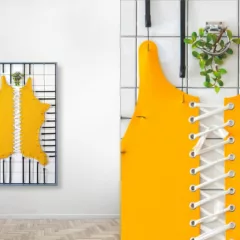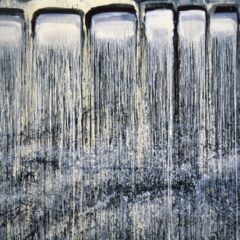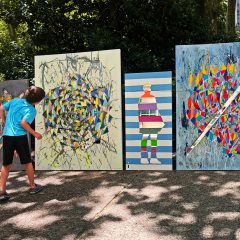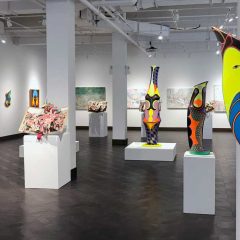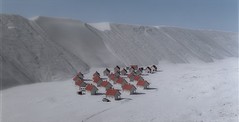
Thomas Wrede, Settlement with a Road, 2005, Digital C-print, 19 x 39 inches, West Collection
Recently appointed Abington Art Center Curator Sue Spaid has thrown the gauntlet down with her first exhibit there, Global Suburbia: Meditations of the World of the ‘Burbs.” It’s a show a little unpredictable and chock-a-block with yummy art worth a chew.
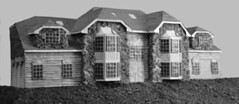
Lee Stoetzel, McMansion #5, 2005 Lambda print, 36 x 57.5 inches
I say unpredictable because the same exhibit has photographic, old-masterish paintings by Sarah McCoubrey of inflatable swimming pools on lawns as well as Lee Stoetzel’s McMansions, photos of model he made from fast-food wrappers and the eats themselves. The exhibit has images of a real landscape that’s stranger than Stoetzel’s fictions, from Arizona native Matthew Moore. And it has a sound installation of not-exactly Muzak emanating from a miniature dropped ceiling, from David Schafer.
The show has a wonderful mix of people with Philadelphia connections and people who have no link to the region or the country. Many of the works in the exhibit draw from the West Collection, which is in nearby suburban Oaks. The collection is a significant grouping of contemporary art.
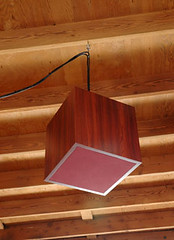
David Schafer, Same Old Bureaucracy, 2004, looped audio cd, powered speakers, wood, plastic laminate, playback system, cables, cloth, 16 x 16 x 16 inches; This speaker box overlays drum solos by Cream, Iron butterfly and Deep Purple. Schafer’s work brings to mind Virgil Marti’s family rec room art as well as their inspiration–suburban rec rooms and dens.
The exhibited works express dismay and longing, love and hate. They ask questions; they answer questions; they crackle with ambiguity.
That same questioning and exploration typifies Spaid’s curatorial essay, filled with juicy facts like the existence of Chinese suburbs with Spanish architecture and names like Napa Valley, or like the most explosive suburban growth is not in the old U.S. of A. It’s a global phenomenon. But its idealization is a product of our own dear television sets.
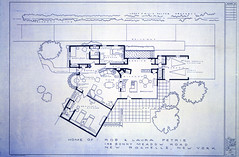
Mark Bennett, Home of Rob and Laura Petrie, 1977, Lithograph, 24″ x 36″, West Collection
I’d be hard-pressed to tell you which piece in this show I loved most of all. So many of them were excellent, from Lee Stoetzel’s full-sized VW bus carved of cypress peckywood–the den on wheels–to Mark Bennett’s architectural plans of the Home of Rob and Laura Petrie and the Home of Mike and Carol Brady. The layouts of the homes are based totally on what image the television shows projected and suggested, not on any actual space.
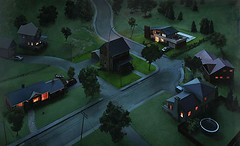
Amy Bennett, You Can Never Go Home Again, 2006, oil and varnish on panel, 22 x 36 inches, West Collection
Amy Bennett’s painting, You Can Never Go Home Again, depicts sealed suburban houses emitting an inaccessible glow from their windows. Michael B. Miller’s gorgeous drawing of mall denizens, minus the mall, reminds me of Robyn O’Neil’s trees minus the land on which they grow.
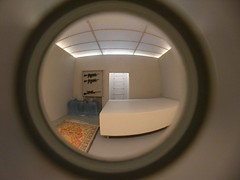
Mark Shetabi, The Rapture, detail of the bunker through the peephole, 2005, plywood, Plexiglas, acrylic, light, polystyrene, cloth, resin, peephole lens
Although I’ve seen Mark Shetabi’s The Rapture, a model of an oppressive gas station concealing an extremist’s bunker, and Hiro Sakaguchi’s many contributions to this exhibit before, seeing them both in the context of suburban life added new layers of meaning for me.

Hiro Sakaguchi, Wind, Flower and Farewell #2, 2006, acrylic on canvas, 21 x 26 inches, collection Anthony Seraphin; the poignancy of leaving home and longing for the past permeates Sakaguchi’s paintings
Hiro’s Humvee Cruiser, for instance, a stretch Humvee so long it has a couple of swimming pools and batteries of guns front and back, suggests a suburban mindset of fear. And Mark’s bunker suddenly became a similar idea. Humvee is to gas station as guns are to bunkers as suburbs are to cities as the American way of life is to the world beyond, with its terrorists and different food styles and alternate ways of thinking and dressing.

Barbara Galluci, Bob and Jess, 2003, Photograph, 20 x 24 inches
A large display of photographs from Ranch 50, by Barbara Galluci, touches on uniformity in tract housing and the triumph of individuality. Her photos of the remodelled TV walls in 50 Levittown houses, all originally identical, is a marvelous display of how people turn things into their very own. You may not like one person’s taste, but how can you not feel admiration for how people impose their private passions and visions on each of the spaces.
This sort of back-and-forth is what makes this show so interesting–
…Chris Ballantyne’s de-contextualized culverts, or
…the Center for Land Use Interpretation‘s book Pavement Paradise: American Parking Spaces (full of interesting facts like the popularity of SUVs causing parking spaces to grow in size)
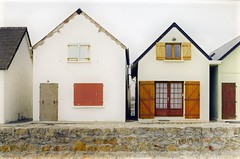
…or Goetz Diergarten’s oppressive line-up of beach houses on the Normandy Coast, or

Eve Struble, 22@development, 2008, paper, vinyl, screen, acrylic, canvas, 26 x 180, courtsy Lombard-Fried Projects
…Eve Struble’s heartfelt 3-D drawing of the cost of high-rise development, or
…Fritz Haeg’s documentation of suburban lawns turned into farmlets, or
…Thomas Wrede’s composed digital images of suburbs as impractical settlements amidst nature, or

Matthew Moore, Rotations: Moore Estates 2, 2005-6, C-print mounted in Plexiglas sandwich, 42″ x 60″, courtesy Lisa Sette Gallery, Scottsdale. At the lower right is the ground torn up by the developer, and in the lower center, in brown and green, is Moore’s planted map of the tract housing, showing (green) sorghum house footprints, and the (brown) wheat roadways. Moore did harvest his map/crop.
…Matthew Moore’s aerial shots of his sorghum and wheat map recreation of the development that was taking over a part of his family farm.
Whatever I am looking at, I find myself thinking about what we gain, what we lose and what’s sustainable in the dash to suburbanization.
The show leads me to consider how nature and human nature are at war, and how America’s taste for a certain kind of comfort may turn out to be the most uncomfortable fit ever.
Tomorrow night, Sept. 12, is the exhibition party, 6 p.m. to 8 p.m. at Abington. $5 general public; Free for members.


